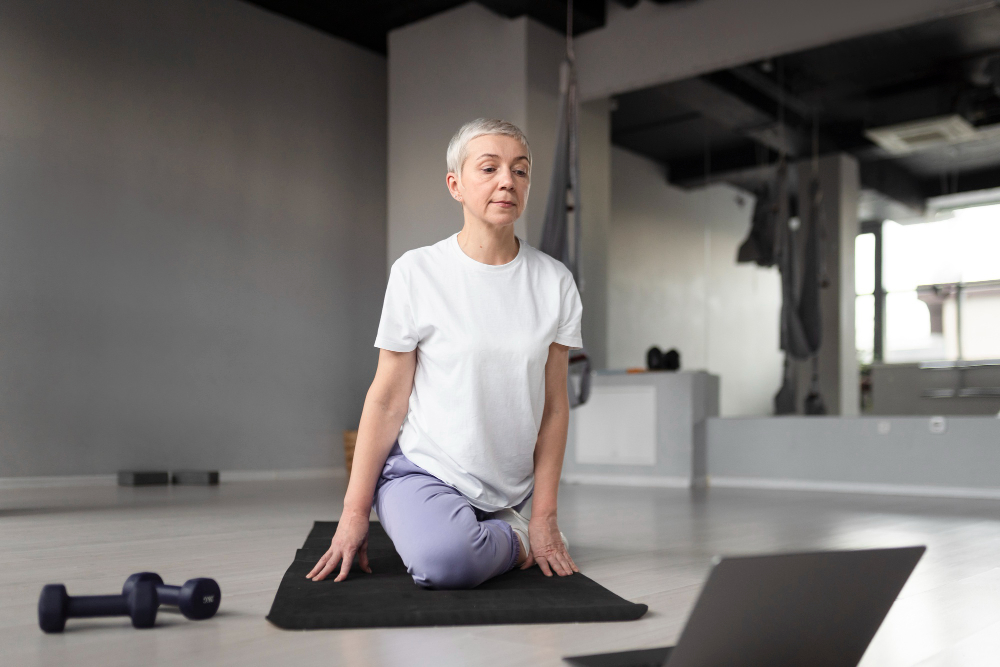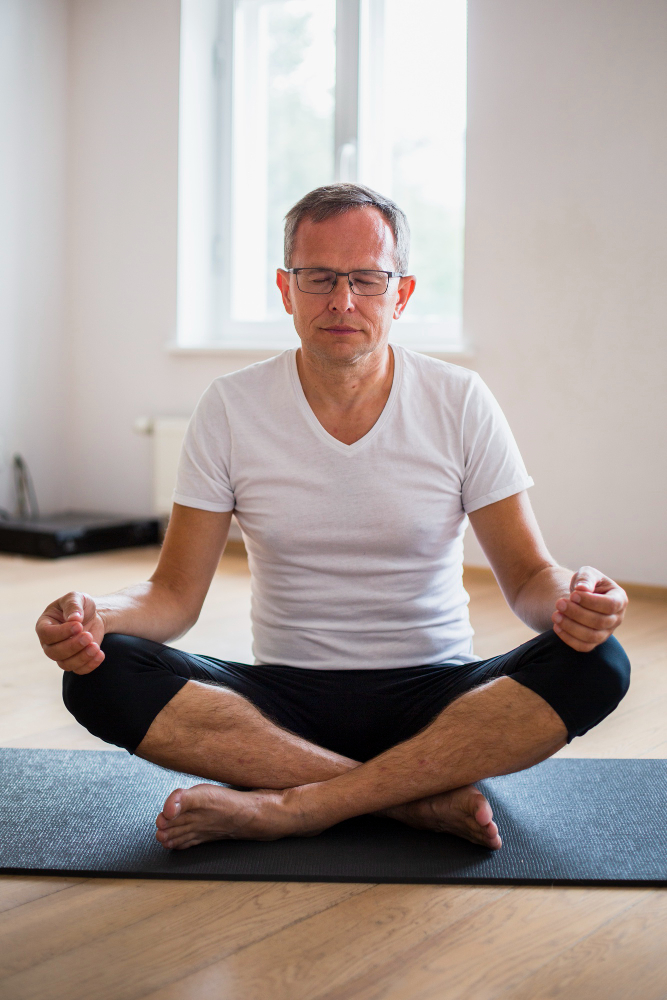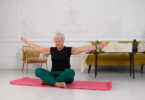Table of Contents
Introduction
“Yoga mature” practices offer a powerful way for older adults to nurture their bodies and minds. By embracing yoga later in life, mature individuals unlock a world of benefits that improve flexibility, strength, mental health, and overall quality of life. Let’s dive into how yoga can help mature practitioners stay active, healthy, and content.
Understanding Yoga for Mature Individuals
Yoga for mature individuals, or yoga for seniors, is designed to help older adults maintain their physical health, mental well-being, and overall quality of life. The practice emphasizes gentle movements, mindful breathing, and modifications tailored to various levels of mobility and flexibility. Here’s an overview of some core benefits and considerations:
Benefits:
- Improved Flexibility and Balance: Gentle stretches and poses help improve flexibility, aiding in everyday movements and reducing the risk of falls.
- Joint Health: Low-impact movements can help increase blood circulation, alleviate joint stiffness, and reduce pain associated with conditions like arthritis.
- Strength and Muscle Tone: Strength-building poses help maintain muscle tone, promoting better posture and stability.
- Relaxation and Stress Reduction: Breathing exercises and meditation techniques reduce stress and anxiety while improving sleep quality.
- Social Connection: Group yoga classes provide a supportive community that fosters social interaction and reduces loneliness.
Modifications:
- Chair Yoga: For individuals with limited mobility, chair yoga allows them to perform seated poses or use the chair for support.
- Props: Blocks, straps, bolsters, and blankets can assist in reaching poses comfortably and safely.
- Adaptive Poses: Certain poses can be modified to accommodate specific health concerns, like high blood pressure or osteoporosis.
Precautions:
- Consult a Healthcare Provider: It’s crucial for mature individuals to consult a healthcare provider before beginning yoga, especially if they have chronic conditions.
- Listen to Your Body: Encourage practitioners to practice within their limits, avoiding overexertion.
- Choose the Right Instructor: An experienced instructor in senior yoga can provide valuable modifications and ensure safety.
Benefits of Yoga for Mature Adults
Yoga offers mature adults numerous benefits, supporting physical and mental well-being. Here are some key advantages:
- Enhanced Flexibility: Gentle stretches help maintain and improve flexibility, making daily movements easier and reducing stiffness.
- Improved Balance and Stability: Balance-focused poses strengthen muscles and improve coordination, reducing the risk of falls.
- Joint Health: Low-impact movements stimulate blood flow and lubricate joints, reducing pain and stiffness associated with arthritis and other conditions.
- Increased Strength: Weight-bearing poses build muscle tone and strength, promoting better posture and stability.
- Stress Reduction: Deep breathing and meditation reduce stress and anxiety, fostering relaxation and better sleep.
- Pain Management: Yoga can relieve chronic pain through gentle stretching and improved circulation.
- Better Circulation: The practice promotes circulation, which supports cardiovascular health and overall vitality.
- Social Interaction: Group classes provide a sense of community and social support, reducing isolation and fostering friendships.
- Mindfulness and Cognitive Health: Meditation and mindfulness practices sharpen focus and enhance cognitive health.
- Adaptability: With modifications like chair yoga or props, the practice is suitable for varying levels of mobility, ensuring safety and comfort.
Best Yoga Styles for Mature Practitioners
Selecting the appropriate yoga style is essential for mature practitioners to ensure they practice safely and reap the benefits. Here are some of the best styles:
- Hatha Yoga:
- Focuses on basic poses, breathing, and relaxation techniques.
- The gentle pace and basic asanas make it ideal for beginners and those seeking a calming practice.
- Restorative Yoga:
- Involves gentle stretching with extended holding of supported poses.
- Props like bolsters and blankets are used for support, promoting deep relaxation and recovery.
- Iyengar Yoga:
- Emphasizes precision and alignment in poses, often using props.
- Suitable for practitioners needing adjustments to meet their specific physical needs.
- Chair Yoga:
- Ideal for those with limited mobility, providing a safe way to practice seated or with a chair for support.
- Accessible to those with balance issues or joint pain.
- Yin Yoga:
- Involves holding passive poses for extended periods to stretch deep connective tissues.
- Promotes flexibility and relaxation, offering a meditative approach.
- Viniyoga:
- Tailors the practice to the individual’s needs and abilities.
- Prioritizes breath control, mindfulness, and adapting poses to suit each person.
- Kripalu Yoga:
- Combines gentle asanas with breathing and relaxation techniques.
- Focuses on compassion and mindfulness, encouraging practitioners to listen to their bodies.
Choosing a yoga style that aligns with the individual’s health condition and fitness level can help mature practitioners enjoy the full range of benefits that yoga provides.

Essential Modifications and Props
Use of Yoga Props
Props like blocks, straps, and chairs provide extra support. Blocks can bring the floor closer during standing poses, while straps help with stretching.
Modifications for Specific Poses
Modifying poses like Warrior or Forward Fold can make them more accessible. Bending knees slightly or using a chair for balance can ease the strain.
Safety Tips
- Listen to your body and avoid pushing too hard.
- Move slowly and control between poses.
- Take breaks and hydrate as needed.
Creating a Sustainable Yoga Practice
Creating a sustainable yoga practice involves developing a routine that fits well into your lifestyle while ensuring long-term physical and mental well-being. Here are some steps to help you build and maintain a consistent, rewarding practice:
- Set Realistic Goals:
- Identify why you want to practice yoga (e.g., stress relief, flexibility, strength).
- Set achievable goals that match your current fitness level and time availability.
- Choose the Right Style:
- Select a yoga style that suits your goals and physical needs, such as gentle Hatha for relaxation or Iyengar for alignment and precision.
- Start Slow and Gradual:
- Begin with short sessions (10-20 minutes) a few times a week and gradually increase the duration and frequency.
- Create a Comfortable Space:
- Designate a quiet, clutter-free space for your practice, ensuring you have sufficient room for movement and any props you need.
- Incorporate Modifications:
- Use props like blocks, straps, and bolsters to support poses and prevent strain.
- Modify poses as needed to accommodate your flexibility, strength, and health.
- Practice Mindfulness:
- Focus on breathing and being present during each session.
- Cultivate patience and avoid pushing yourself too hard.
- Mix It Up:
- Combine different yoga styles and include meditation or breathwork sessions to keep the practice engaging and balanced.
- Find a Community:
- Join group classes or an online yoga community for motivation and support.
- Consider finding a qualified instructor to help refine your practice.
- Track Your Progress:
- Keep a journal or use an app to note your sessions, goals, and improvements.
- Listen to Your Body:
- Avoid overexertion and rest when needed.
- Consult a healthcare professional if you’re managing chronic conditions or injuries.
FAQs
How often should mature adults practice yoga?
A consistent practice of 2-3 times per week is beneficial. Start slowly and build up to daily sessions if possible.
Is yoga safe for those with chronic conditions?
Yes, but consult your doctor first. Seek classes or instructors familiar with modifications for chronic conditions.
What equipment do I need to start?
A yoga mat, a chair, and some props like blocks and straps are useful. Comfortable clothing is also important.
How can I find age-appropriate yoga classes?
Look for classes labeled “gentle,” “restorative,” or “chair.” Many studios offer specific classes for mature adults.
What is the best way to warm up before yoga?
Simple stretches like shoulder rolls or neck stretches, along with deep breathing, can prepare your body for practice.
Conclusion
Yoga for mature adults is about meeting yourself where you are and nourishing your body and spirit. It’s a path to better mobility, mental health, and inner peace that can be practiced by anyone, regardless of age or ability. So roll out that mat, take a deep breath, and start your journey to wellness today.
Related Article:
- Chair Yoga for Seniors: A perfect option for those with limited mobility, chair yoga provides all the benefits of yoga while using a chair for support during poses. Read more in the article “Chair Yoga for Seniors: A Free Guide to Enhanced Wellbeing.”
- Yoga for Men Over 50: For mature adults looking to build strength and balance, certain yoga poses are particularly helpful. Discover some of these in the article “Incredible Yoga Poses for Men Over 50”.
- Gentle Exercise for Seniors: A holistic approach like yoga can positively impact flexibility and balance in mature adults. Learn more in “Yoga for Seniors: A Gentle Way to Stay Active and Healthy.”
- Weight Loss and Fitness through Yoga: Aging shouldn’t stop you from maintaining a healthy weight. Learn how to achieve this with “Yoga for Weight Loss for Seniors: A Gentle Approach to Fitness.”







